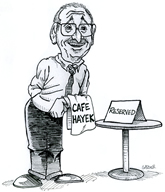U.S. Steel isn’t just getting nationalized. It’s getting … personalized?
President Donald Trump will personally control the so-called “golden share” that his administration has forced U.S. Steel to accept as part of the terms of a deal that will see the previously private company get acquired by Japan-based Nippon Steel. It’s an utterly absurd arrangement—one that will leave the federal government with a controlling share of U.S. Steel even after Trump leaves office—that gives Trump the power to block future attempts by U.S. Steel to relocate its headquarters or make changes to its production facilities.
Documents filed this week with the Securities and Exchange Commission (SEC) spell out the specifics of the deal. Trump must provide “written consent” before U.S. Steel will be allowed to change its name, relocate its headquarters, reduce or alter any planned capital investments, “close, idle, or sell” its existing plants, or attempt to acquire any part of a competing business.
In short: Whatever decisions are made by U.S. Steel’s executives and shareholders (or by Nippon, which will own U.S. Steel) will require approval from Trump, his appointees, or his successors.
I think we have a fundamental mismatch. There is an excess supply of college professors. We deal with this by artificially boosting the demand for college.
Think of the students who are excited by academic subjects as the natural demand for college education. In the late 1960s, when the Baby Boom started to reach college age, their large numbers raised the natural demand for college. But the supply of college professors was not high. It was a great time to expand the supply of college professors by enlarging Ph.D programs.
By the late 1980s, the supply of professors had increased by more than enough. As the Baby Boom gave way to later generations, the natural demand for higher education leveled off and has been falling for quite some time. But the machinery for producing new Ph.D’s has not adjusted.
What has adjusted has been an increase in artificial demand for college, meaning students who are not excited by academic subjects.
The size of the problem is staggering. Social Security’s shortfall now equals 3.82% of taxable payroll or roughly 22% of scheduled benefit obligations. Avoiding insolvency eight years from now would require an immediate 27% benefit cut, according to former Social Security and Medicare trustee Charles Blahous.
Alternatively, legislators could raise the payroll tax from 12.4% to 16.05%. That’s a 29.4% increase. Or they could restructure Social Security so that only people who need the money would receive payments. But because facing this problem in an honest way is politically toxic, legislators are ignoring it.
Blame does not rest solely with Congress. The American public has made it abundantly clear that they don’t want reforms. They don’t want benefit cuts or tax increases, and they certainly don’t want higher retirement ages. So politicians pretend everything is fine.
Congress does deserve fresh criticism for making things worse. Last year, legislators passed the misnamed “Social Security Fairness Act,” giving windfall benefits to government workers who didn’t pay into the system — which enlarges the shortfall. This year, the House proposed expanded tax breaks for seniors in the “One Big Beautiful Bill Act,” which would further worsen the problem.
The cost of political giveaways is steep. Social Security’s 75-year unfunded obligation has now reached $28 trillion, up from $25 trillion just a year ago.
The grocery market, which includes bodegas, grocery stores, supermarkets, and online grocery delivery (like Amazon, Walmart, and ShopRite), is incredibly competitive in New York City, and its market concentration is extremely low. Based on 2016 market share data (the most recent year data are available) from Chain Store Guide, a provider of retail and foodservice intelligence, the New York metropolitan area’s grocery market has a Herfindahl-Hirschman Index score, a measure of market competitiveness, of approximately 550 (an index score below 1500 is considered to be competitive).
Despite the competitive market, food prices in New York City (and the rest of the country) have risen. The cost of food at home, a good proxy for the price of groceries, increased by 27.5 percent between FY 2019 and FY 2023 in the New York City Metropolitan Area, according to an April 2025 report from the Office of the New York State Comptroller using Bureau of Labor Statistics data. However, this price increase was not caused by the city’s 1,002 grocery stores focused on “making a profit”—grocery store profits range from 1 percent to 2 percent, Adam Lehodey explains for City Journal—but by inflation caused by federal spending and supply chain crunches.
Look, obviously I opposed Obamacare and am not a huge fan of government healthcare provision. But at least healthcare has a bunch of specific market failures that you can argue government will solve. Grocery is fiercely competitive and extremely efficient, and NYC does not have economies of scale compared to a national chain.
[DBx: If recent history is a good guide, it won’t be long before large numbers of Republicans join the socialists in demanding that grocery stores be run by government.]
New York is also unusual in that trash collection for residences is provided by the city, while businesses pay for private service. Keeping the service unpriced, as New York has done, denies the city access to the information that prices communicate, making it harder to know what’s needed where and at what times.



